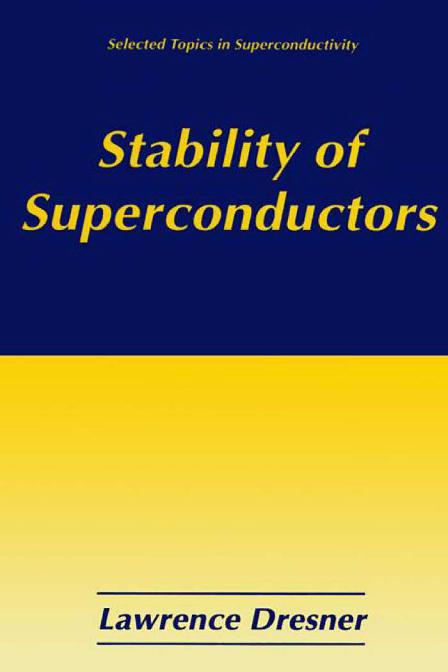
Dresner, Stability of superconductors.2002
.pdf

Stability of Superconductors

SELECTED TOPICS IN SUPERCONDUCTIVITY
Series Editor: Stuart Wolf
Naval Research Laboratory
Washington, D.C.
CASE STUDIES IN SUPERCONDUCTING MAGNETS
Design and Operational Issues
Yukikazu Iwasa
INTRODUCTION TO HIGH - TEMPERATURE SUPERCONDUCTIVITY
Thomas P. Sheahen
STABILITY OF SUPERCONDUCTORS
Lawrence Dresner
A Continuation Order Plan is available for this series. A continuation order will bring delivery of each new volume immediately upon publication. Volumes are billed only upon actual shipment. For further information please contact the publisher.

Stability of Superconductors
Lawrence Dresner
Oak Ridge National Laboratory
Oak Ridge,Tennessee
Kluwer Academic Publishers •
New York / Boston / Dordrecht / London / Moscow
eBook ISBN: |
0-306-47064-0 |
Print ISBN: |
0-306-45030-5 |
©2002 Kluwer Academic Publishers
New York, Boston, Dordrecht, London, Moscow
All rights reserved
No part of this eBook may be reproduced or transmitted in any form or by any means, electronic, mechanical, recording, or otherwise, without written consent from the Publisher
Created in the United States of America
Visit Kluwer Online at: |
http://www.kluweronline.com |
and Kluwer's eBookstore at: |
http://www.ebooks.kluweronline.com |

To my grandchildren, Matthew, Stephanie, Brian, Jacob, Aaron, Benjamin, Danielle, Chelsea, Haley, Micah, and Max

This page intentionally left blank.

Read not to contradict and confute, nor to believe and take for granted, nor to find talk and discourse, but to weigh and consider.
—Francis Bacon

This page intentionally left blank.

Preface
The science of superconductivity is split into two parts, each of which is coherent within itself and which are joined by a common interest in superconductors. One part is peopled by solid-state physicists, metallurgists, and materials scientists who try to understand why superconductivity exists and try to use that understanding to make better superconductors. The other part is peopled by physicists, cryogenicists, and engineers who take for granted a superconductor created in the first part and try to answer the question, “How shall I make a magnet from this superconductor?”
The workers of the first part, the materials people, deal with the quantum mechanics of the solid state. The workers of the second part, whose field I call applied superconductivity,deal only with classicalphysics: electricity and magnetism, fluid flow, heat transfer, stress, and strain. It might be thought that classical studies are less adventurous than quantum studies, but applied superconductivity has a novel twist that gives it great intrinsic interest. This twist is the fundamental instability of superconductors: if a superconductor ever loses the property of superconductivity, that is, becomes resistive, this loss tends to become worse, not better; the superconductor departs more and more from the superconducting state. How this comes about, when it happens, and what one can do about it are the subject of this book.
I have written this book to appeal to as wide an audience as possible. To do so I have composed two intertwined texts. The simpler text, appearing in unmarked sections, is suitable for a first reading or for use by persons not having extensive training. The more detailed text includes sections marked with a diamond, which contain more advanced material. In addition, notes on special points have been added at the end of each chapter that can be consulted if the reader desires, but ignored without risk of breaking the continuity of explanation. This book should interest senior undergraduates and graduate students in physics and engineering, as well as workers already in or just entering the field of applied superconductivity.
ix
